Shenzhen I/O Game Review¶
I don't usually game.[citation needed]
Sometime in 2021, in my first days of university, I felt bored and bought this game. Also out of vanity to show how different I am from my league of legends roommates. (it didn't work because i got stuck at assignment eight and gave up, until december 2023 when i decided to give it another spin now that i've made a few PCBs and written some assembly in real life)
What is this game¶
Shenzhen I/O is a "nerd puzzle game" (my words) by Zachtronics.
You move to Shenzhen and work as an employee at 龙腾 (Longteng), where you combine chips into circuits that meet client specifications. In each level (assignment), you are given a canvas like this one:

Then you complete these tasks, in the general order:
- Drag parts from the sidebar
- Connect parts with each other and I/O pins on the sides
- Write assembly for the programmable chips
- Simulate and debug until output matches expected waveform
The assembly language in question is invented specifically for the game. The chips are fictional, too. It doesn't actually require prior embedded systems knowledge. A few differences from real-life embedded systems:
- No need to explicitly power the chips
- No need to worry about clock cycles
- Everything seems to use decimal, not binary
- Hardly any boolean operations
- Voltage levels range from 0 to 100
- ADC/DAC are perfectly accurate
- Integers range from -999 to 999
- MCUs have two registers max (
accanddat), and no SRAM - XBus, the asynchronous protocol, seems too complicated for one clock cycle
- Multidriver problems are handled simply by
input = max({outputs}), and can be abused
And mostly importantly, the debugger is something I wish I had in real life. You can literally step through the instructions! Imagine if you were able to freeze time, poke an ATmega328P and know which loop it's stuck in.
That said, I'm not the best at this game. Hell, I'm not even good, as I have created abominations like:
Spoiler
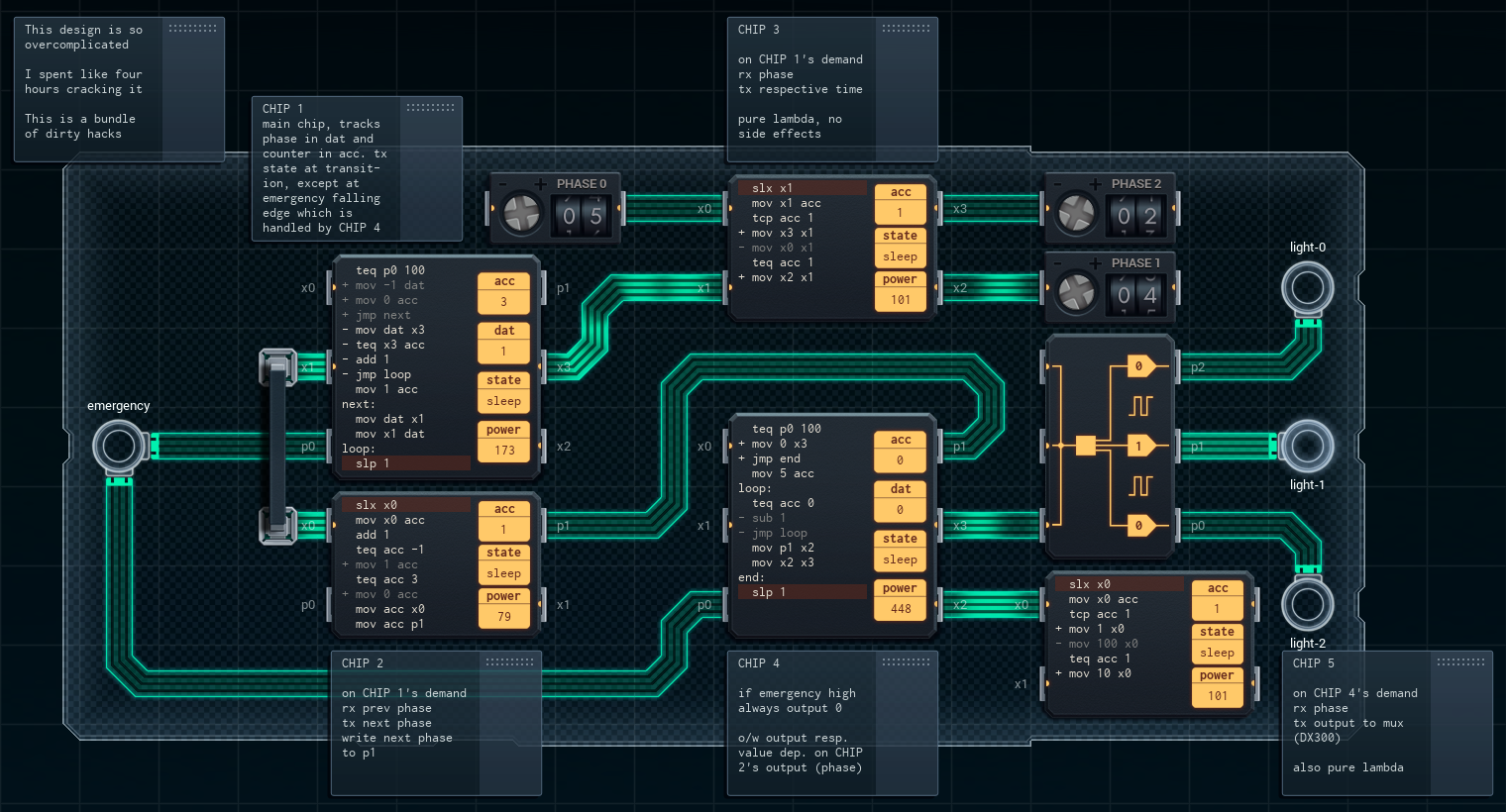
After you complete each assignment, the game shows you where you are among all the players. The data I got was:
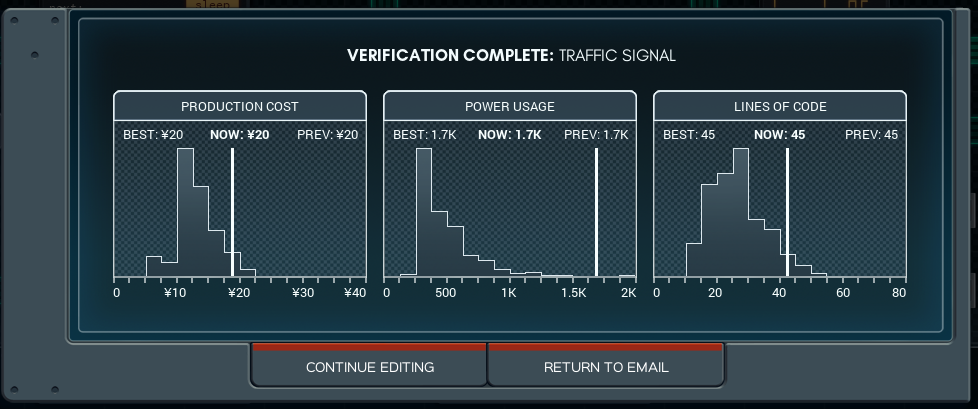
The current best for three metrics on the leaderboard are:
- Lowest cost: 6 yuan (mine costs 20)
- Power usage: 123 (mine uses 1.7K)
- Lines of code: 9 (mine has 45)
As you can see, my solution is far from good in whichever way, but nevertheless it works. This is because there are so many ways to solve a problem, and to optimize a solution.
That said, am I going to optimize my solution? No.
Why is it fun¶
Like all puzzle games, it is fun because it's intellectually challenging. It's not the kind of Genshin Impact minigame.
Another reason is the plot. For most of the game's target audience, living in Shenzhen would be a foreign experience, and it's a lot of fun reading coworkers (both Chinese and from abroad) react to projects and life. The game's UI involves a mail client, where you receive emails from your supervisors and coworkers, and honestly that's half the fun.
(lets ignore the fact that most chinese companies dont discuss everything over email)
Spoiler alert!
My favorite emails are:
- When you designed a vape as merchandise for musician Cool Dad, who, once the vapes were manufactured, got arrested for possession of amphetamines. Also, Carl absolutely roasted Cool Dad's music.
- When you designed a laser/illuminator apparatus for law enforcement weapons and Carl responded with brutal sarcasm out of moral concerns. I kinda wonder if the correct move is not to design it, but it's too late.
- When Joe proposed a haunted doll implemented with unmarked chips of unknown origin, and was then forbidden from venturing further in the field of "ghost electronics"
- When a Japanese company claims to have developed a "traditional yarrow stalk I Ching divination" with "MEMS technology"
Why is it hard¶
You have to read the datasheet¶
The game comes with no manual; instead it ships a PDF containing all the datasheets and supplementary materials. Fortunately they are much easier to understand than those in real life. And they are (mostly) typeset very well. Much more pleasant to the eye than many actual industrial datasheets. In the one case it isn't, it's definitely intentional for a "sketchy" vibe.
Chips are intentionally underpowered¶
We know modern chips are extremely powerful. So powerful it would render the game pointless. So the chips and assembly language in this game are intentionally limited. The smaller chip only holds 9 instructions, the larger one 14.
I sometimes find it hard to implement any meaningful logic with such an underpowered chip. Once I found a solution that was 15 lines long, but I had to split them in two chips, and then I had to write extra code so they could communicate, which is another 10+ lines of overhead.
Hardware-wise, the chip has 6 pins max, and you can't just use any pin, because some pins are "simple", and some are "XBus".
Conditional instructions are cursed¶
There's no actual "conditional branch". Give the chip a condition (e.g.
teq acc 1 tests if acc == 1) and it sets a global state (+/-). Then
you can prepend a +/- to an instruction so that it only runs in the state.
The global state makes it really hard to emulate nested if statements.
Pretty sure there were actual ISAs that used this mechanism, but I always
get confused on this logic.
Labels count as lines?¶
If you wanted to jump to an instruction, you have to label the line, like
loop:
add 1
jmp loop
It should make sense to any programmer that labels are not real. They are just a fancy way to refer to the line number it precedes, and thus should not count as a line. But in the above code it does, because the text area only has so many rows. This leaves me with one less line for actual instructions. It took me way too long to realize that this is legal:
loop: add 1
jmp loop
The datasheet never mentioned this! I was looking at the leaderboard when I found out.
Canvas size is limited¶
The wire traces take a significant amount of space and there is only one side, so no vias. They will sometimes block pins. The only way to cross two wires is to use a bridge, which only comes in one size and direction. I have more than once made a circuit that looks like an absolute jumbled mess. Like what even is this
Spoiler
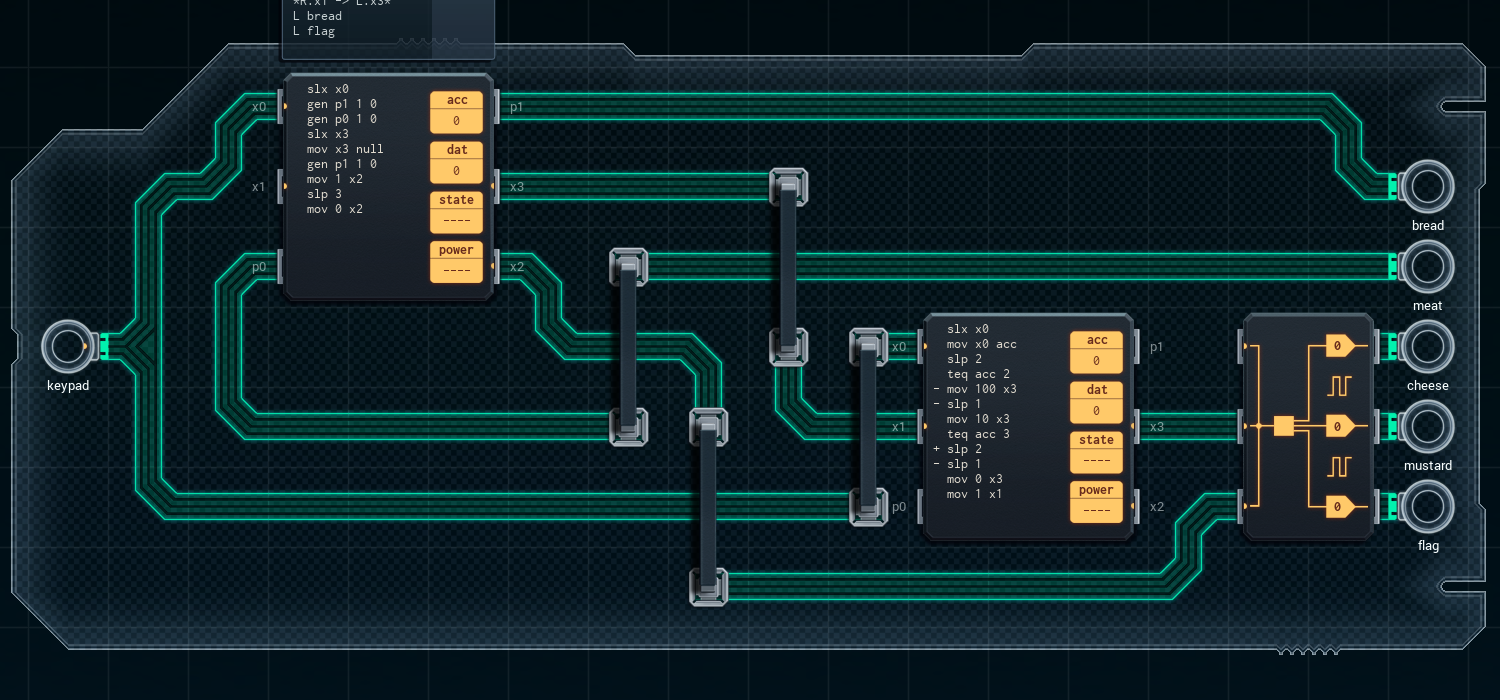
There was one level where I just can't get the wires to go where they should. I tried every direction possible to route the wires, but there's either not enough horizontal space or enough vertical space. The most disgusting thing is this kind of notch that you can't route wires through. These notches made two hours of my life miserable. I almost gave up.
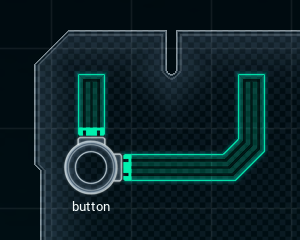
Then I downloaded a solution from the leaderboard, only to find that, like in real life, you can route traces below the chips. Nobody mentioned that! There was nothing in the manual that explicitly said this was ok, nor was there any hint in the game. The hack is only accessible if you hold Tab, which enters "show wires" mode, and the chips become translucent so you can route traces underneath.
Spoiler
Normal view:

When holding Tab:
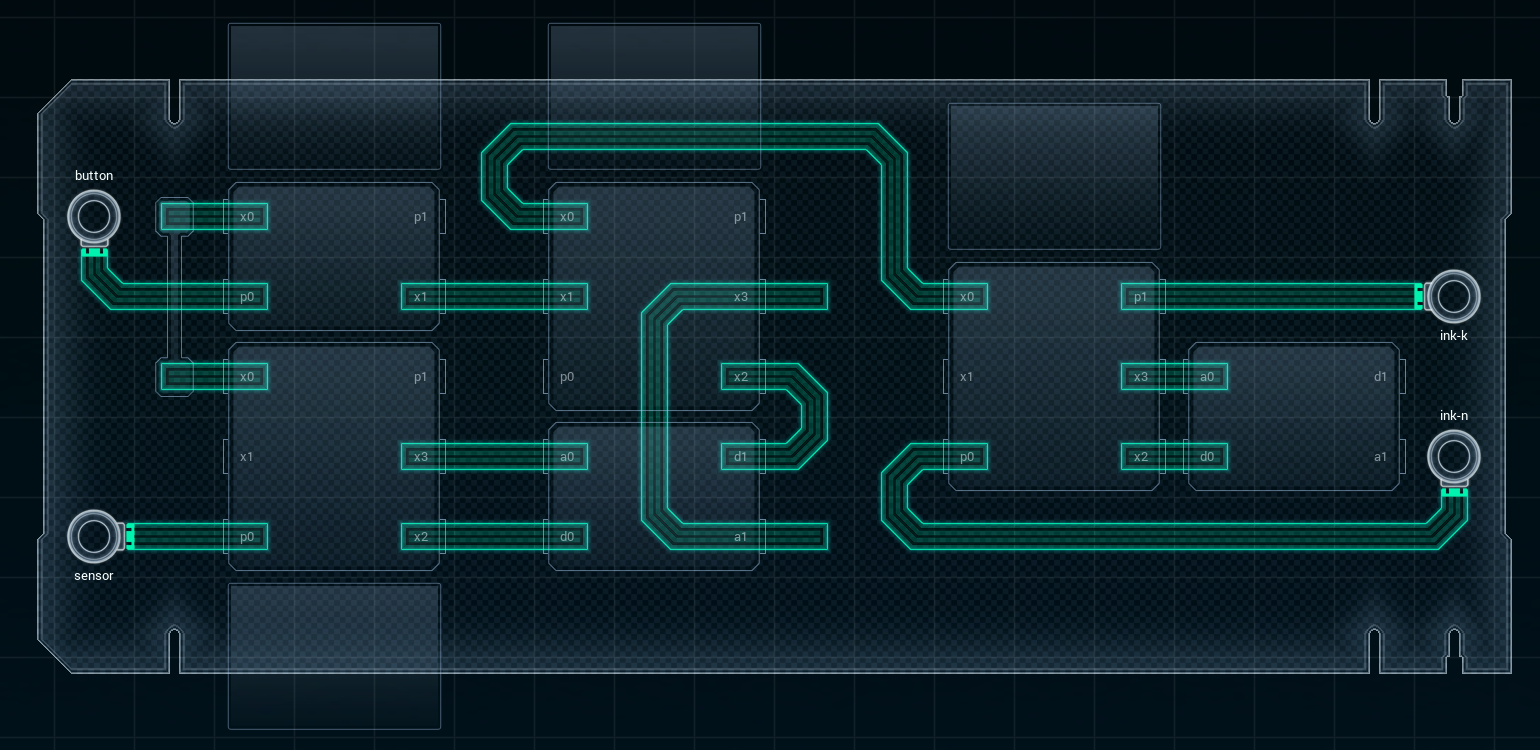
I doubt this assignment is possible without this kind of hack. Anyway, I deleted the leaderboard solution and made my own version, and I'm never looking back.
Hardest assignments¶
These are a list of assignments that I felt stuck on for more than an hour.
Spoiler
- Virtual reality buzzer (the level that led me to quitting in 2021)
- Precision food scale
- Traffic signal
- Color changing shoes (titled "Would you believe it?" in game)
Again, I'm not good at this. If I had to find an excuse, it would be that I try my best to come up with the most elegant solution possible, however many lines it takes. I'd use a divide & conquer approach that's as symmetric as possible, which is not always optimal, and sometimes uses up too much of space and makes a mess of wires.
A nitpick on the awkwardness of languages¶
The game is created by a bunch of Americans, for, I suppose, a primarily English-speaking audience. Despite this, the game and the datasheets are available in both English and simplified Chinese. The problems are:
- The Chinese does not sound Chinese
- The English does not sound Chinese
If you tried to play the Chinese version as a Chinese person, as I have, you will find the Chinese dialog awkward. The translator did their best, but it sounds un-Chinese.
They are grammatically correct, but I find this sort of conversation out of place in a Chinese workplace. However, I would prefer if real life workplace conversations sounded like this. Light-hearted without much 客套话 (formalities). Let's hope society evolves that way.
On the other hand, if you play in English, you'll find that your Chinese coworkers have extraordinarily high English competency, atypical of current day Shenzhen (but the game is set in the future, so one can hope).
Minigame: Shenzhen Solitaire¶
Early in the game a coworker introduces a solitaire-style game with Mahjong-themed cards. It's a way to relax when I'm stressed out solving a puzzle. I like it so much that I rewrote it in Rust.
Conclusion¶
At the time of writing, I have not finished the game (yet). So far it's really enjoyable. I did stress myself out a handful times halfway; that was because I was not treating it as a game. Once I accepted the fact that I'm just a casual player and being unable to solve the puzzles does not result in any loss of self worth, I was again ready to have fun.